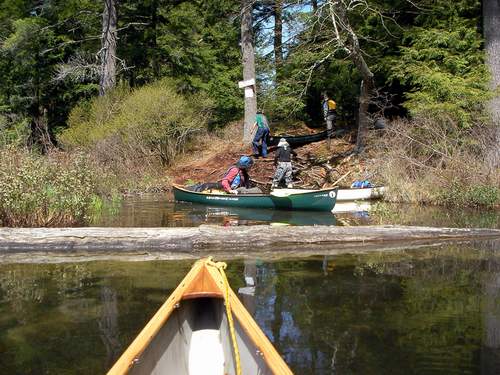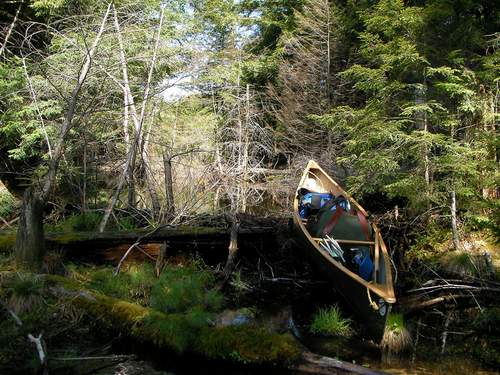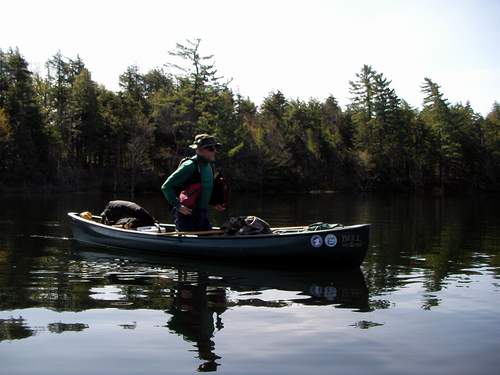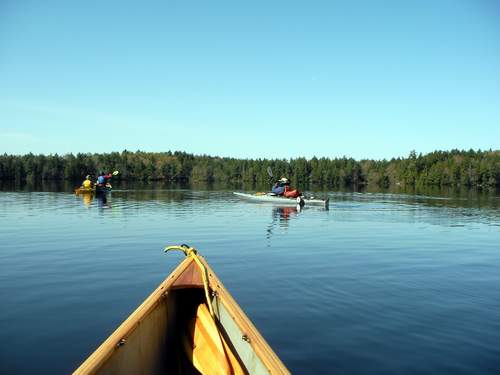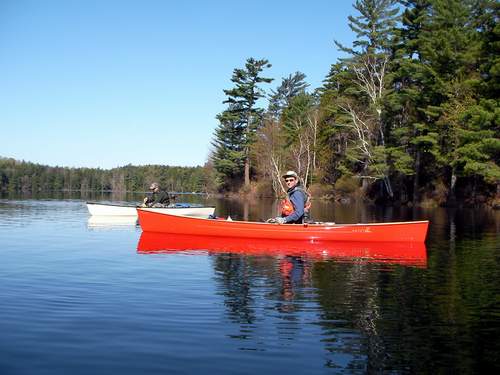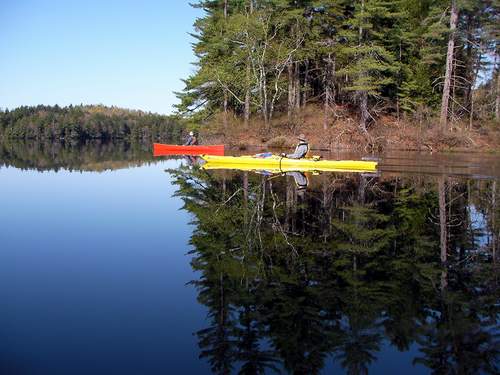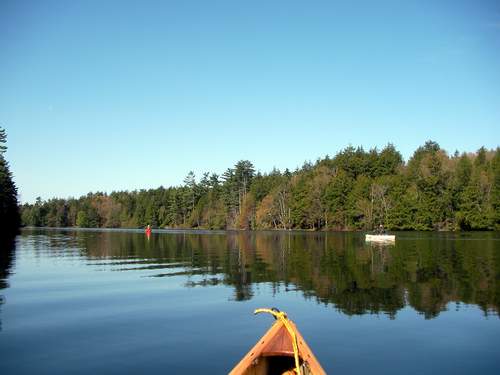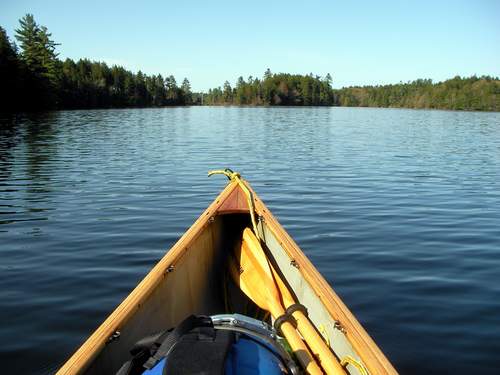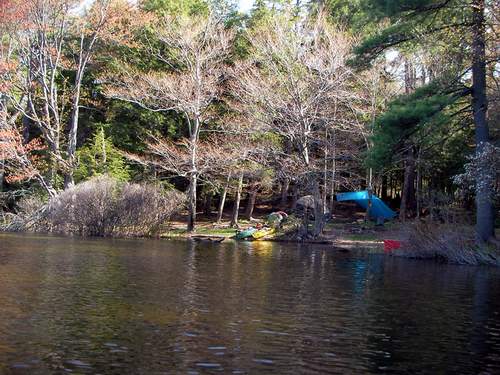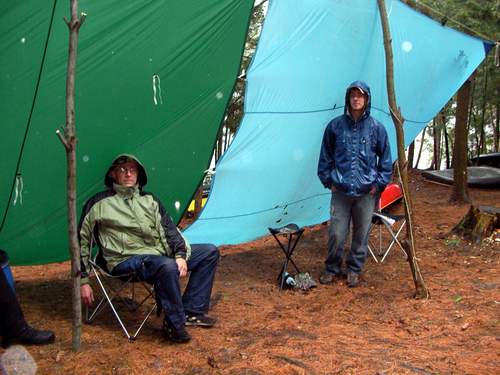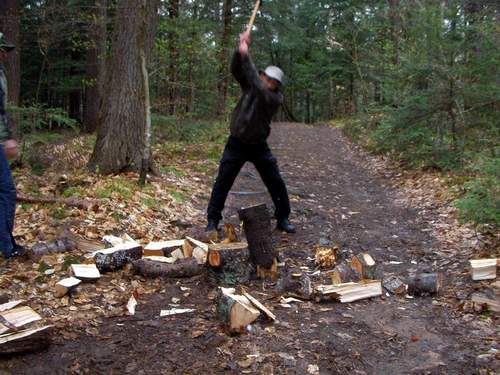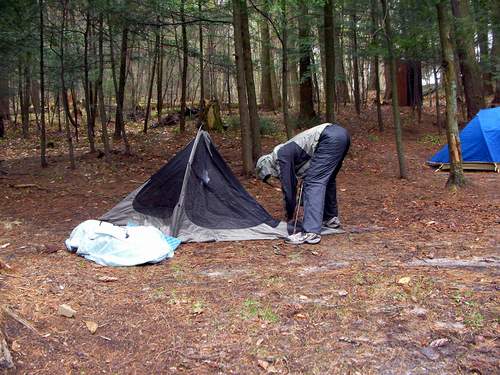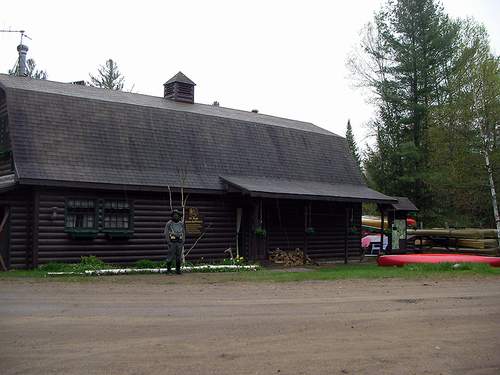The Best Laid Plans
or
Pond Hopping in the ‘Dacks
by Jeff Bowen
St Regis Canoe Area, Adirondacks
May 14-16, 2009
When I read that the Club’s Activity Schedule listed an overnight paddle and camp trip in the Adirondacks, I was immediately interested. As I read further it became apparent that the planned trip was of a different type than the "base camp" type of trip, or the shorter weekend overnighter I was more comfortable with. This trip called for camping in a different spot each night, and included carries, what portages in the Adirondacks are called. It meant that we would be traveling light leaving behind many luxury items, and doing most of our paddling with boats fully loaded. Despite some mild apprehension, I was determined to go, especially since the trip was planned for an area of the 'Dacks I had not visited before.
Fat Elmo and I had managed to get some extra time off from work, so we headed up in a leisurely fashion a day early, stopping to sample some of the gastronomical delights offered in the region. We reconnoitered the put-in where we were to meet the next day, and finally settled in to a DEC campsite to sleep for the night. It was a Thursday night, and early in the season, and the campsite was mostly empty. The loons serenaded us as we bivouacked in the truck.
The next morning we were up early and headed to Tupper Lake to get breakfast in a local diner. Then we did some more sight-seeing, and ended up at the designated put-in. About that time we noted that it was cloudy, and yes, there were periods of rain. To be sure, it was light rain, and intermittent, and by itself could be easily dealt with or even ignored. What was more noteworthy was the wind. It was strong and headed right down the lake towards the put-in.
Fat Elmo and I were content to sit in the comfy confines of the cab of the truck and watch as a foursome of adventurous guys proceeded to launch their small motorboat and a small canoe. Their raingear consisted of some new vinyl ponchos, and their gear was packed in household garbage bags, except for some of the new stuff, like the open cell egg crate foam mattress one of them brought which was still in its original plastic packaging. Fat Elmo and I might have grunted a couple of times and maybe giggled a little as we thought how lucky it was that if this group of sportsmen flipped their boats it would probably be close to shore and that the wind would soon drive them and any of their gear that floated back to the put in. We probably wouldn't even need our throw bags to assist in their rescue, and would mostly be picking up the flotsam and jetsam of their gear from the shore. Any criticism we may have had was muted by the fact that we were both intimidated by the prospect of launching our boats and paddling out into the stiff wind.
Still, we waited for the arrival of the rest of our group, confident that we would find an acceptable "Plan B". We did not wait long. Soon we received a call from Scott, the Trip Coordinator. He informed us that he had already ascertained that the conditions were not favorable for our original plan, and had already taken steps to insure that our trip proceeded smoothly. He soon joined us and led us to a different campsite on the shore of Polliwog Pond where we could await the arrival of the rest of our group and for the weather conditions to improve. We set about setting up our tents and a tarp windbreak/rain shelter, and were soon joined by Dave and his son Dennis, and by Ralph.
Scott had arranged to have some of his friends who lived locally drop by to deliver some firewood and a maul with which to split it for our evening campfire. Some of us took turns swinging the maul, and we all carried the wood down to where we hoped we would be able to light a fire between the showers and the wind.
It was exciting and comfortable to sit in my chair behind the windbreak, all wrapped up in my Gore-tex pants and jacket, and the broadcasts on the NOAA weather radio station gave me hope for the morrow. Diminished winds and sunny skies. All we had to do was relax and enjoy the rest of the afternoon, evening and night, and wait for Phil, who was scheduled to arrive later.
Scott was running a shuttle for our vehicles, which we could leave safely in the driveway of his local friends. Those of us back at the campsite received his call via cell phone. Plan B was about to morph to Plan C. "C" as in Charlie's Bar. Did we, Scott asked, feel like spending some time at Charlie's bar having beer and burgers? After all, we were unable to paddle right now due to the wind, and Charlie's offered...there was discussion going on in the background on Scott's end of the line. Plan C was in flux. Soon we were discussing Plan D.
So we ended up at the charming cabin of Cindy and John, Scott's friends. There we shed our dripping raingear, warmed ourselves by the woodstove, watched the satellite imagery of the rain squalls on the weather channel, sipped wine and beer, enjoyed fascinating and lively conversation, and feasted on salad, pasta, chicken and vegetables with fresh bread with ice cream and cookies for dessert. Yup, ya gotta be flexible.
Back at the campsite that night, after most of the rain had passed and we were getting ready for bed, Phil finally arrived, tired but excited at the prospect of the trip. None of us had the heart to tell him what he had missed. If he's reading this now, it's probably the first he's heard of it.
The next morning dawned bright and clear over the still waters of Polliwog Pond. Scott was out for an early paddle as the rest of us ate a quick breakfast and packed our gear. Packing gear for a trip like this requires the ability to pack light and tight and quickly. I found I needed a bit more time than I had anticipated in getting the gear packed and into my boat in a way that I felt was proper. We would be facing several carries that day, and although I would be unable to do the carries in one trip, I was hopeful I would be able to carry my boat and all my gear in just two trips. I didn't want to be the one that was holding up the procession, or requiring too much help from my fellow trippers.
We set off across Polliwog Pond in classic Adirondack surroundings. The trees on the far shore and their perfectly inverted doppelgängers on the mirror surface of the pond had the light green shades of springtime. Up here spring was a couple of weeks behind what it had been in New Jersey. The low morning sun was warm and inviting, and the boats moved well along the surface.
We reached the site of the first carry rather quickly, almost too quickly it seemed. This was no easy, casual put-in or take-out. It was narrow, allowing only one boat at a time, and there was a steep bank which complicated the unloading of gear, especially from so many of us. But, we set about doing it as best we could, taking notes and learning little lessons along the way. The carry was short, and soon we launched again on Little Polliwog Pond.
Little Polliwog Pond was much smaller, as one might guess from its name. Afloat on the middle of the pond you could imagine yourself dropped into the middle of the wilderness. It was lovely, but we did not tarry long. In only about 100 yards of paddling we found the next carry. Again, access was limited to only one or two boats at a time, and again, it was a relatively short carry. Fat Elmo elected to attempt to float his fully loaded Independence across the beaver dams and through the small stream that led to Horseshoe Pond. He was in water up to his chest in several areas, but did not seem to mind. He made it through just as quickly as those of us who carried overland, although he may have worked a bit harder.
On Horseshoe pond we saw other people and their boats, and a few campsites with tents set up and gear drying in the sun. We paddled from one arm of the lake across the loop into the other arm, and made our way to the next carry. It was not quite noon yet, and we were beginning to get the hang of these carries.
The trick is, of course, to find the right balance between what you need, bulk, and weight. True experienced trippers and voyageurs outfit themselves so that they can carry their boat and all their gear in one trip. Less able persons such as me had to make one trip with my boat, paddles and other light gear, then return and make another trip with my camping gear. That means covering the distance of the carry three times. It is easy to see why traveling light is so important in this type of paddle/camping trip. Coolers and canned or bottled food and drink are heavy, and meals should be planned accordingly. Packing, loading and unloading the boats is time consuming, and modular organization of packed items is recommended. A large backpack or Duluth pack which can accommodate gear packed in waterproof bags will allow you to carry a lot of gear on your back when your hands are full, or busy carrying your boat. The carries often require that you get your feet wet, so appropriate footgear is essential. The conditions you are likely to encounter on a carry may range from muddy to rocky to wet slippery logs. Good footwear has to be rugged enough to endure the terrain, have adequate traction on a variety of surfaces wet & dry, offer ample support & protection, dry quickly and be comfortable in & out of your boat.
Arriving with all our gear at Follensby Clear Pond, we sat, took a short break and had some lunch. Fat Elmo wandered into the lake and was soon happily bobbing about just off shore in his PFD. Our TC cheered us with the news that we had probably done our last carry that day. Now the paddling would begin in earnest.
Across Follensby Clear Pond, through the culvert under the road and into Spider Creek Passage to Fish Creek Ponds and then up Fish Creek and into Little Square Pond we paddled. We stopped to check out some campsites and then continued up the creek to Floodwood Pond.
There, on the large island in the middle of Floodwood Pond we sought our campsite for the next night. We chose a large open campsite facing west, and we set about setting up camp for the evening. The weather was beautiful and the wind had died down considerably, and the temperature was just right. Then they attacked.
Up to this point we had noted that there were some of the predatory blackflies around, but on the island their numbers had increased, and they had developed a taste for humans. As soon as you sat still you would be surrounded by clouds of the tiny demons that would find any exposed skin and wreak their horrible vengeance. Head nets or bug nets and bug shirts were brought out to keep them at bay.
It takes a little getting used to, living in a bug net. More than one of us found ourselves forgetting that we were wearing them and trying to put a morsel of food into our mouths through the head net, or attempting to drink through the head net, or, more comically, sneezing or trying to blow our nose through the head net. But the learning curve was a steep one, and the downside of these gaffes was better than the torment that began if we freed ourselves from the head nets. And we learned quickly. It helps to have a brim of a hat to keep the head net off your face, for example. It also helps to have shirtsleeves that go all the way to your wrists. Of course, it is vital to have a tent that has screens on the windows. Even Dave, who usually camps under an open tarp, had brought a tent to sleep in for this trip.
The island was large, about ten acres in size I guess, and there was a mixture of hardwoods and conifers. There were about four campsites on the island, but we had chosen the largest, most open site with ample space to unload and store the boats. There was enough firewood on the island to allow us to have a nice campfire that evening. We set about cooking our dinners, and looking forward to nightfall and the retreat of the blackflies. Of course, as the blackflies left the mosquitoes moved in, but the same protocols that deterred the blackflies worked well for the mosquitoes as well. Sitting near the smoky campfire seemed to help. I spent a couple of minutes looking for blackflies or mosquitoes that had hitched a ride on me as I entered my tent, but fell asleep quickly to the lullaby of the Adirondacks.
In the morning we were greeted by fine sunny weather, and for a while, the absence of the blackflies. We ate our breakfast and discussed our plans. The NOAA weather radios were making alarming predictions at which we would not have guessed using casual observation. It was about this time that we discussed changing the trip plan again. By this time we had lost track of which change it was. We had gotten used to the fact that adaptability and flexibility were essential. It was decided that we would spend the early part of the day in a leisurely fashion, and then pack up our gear and paddle out to the end of the lake where our TC had arranged to have his car for the shuttle.
It was early afternoon and the weather had been growing more and more threatening when we finally all launched our loaded canoes and kayaks and headed for the end of the lake. Right on cue, it started raining…HARD. Well, it wasn’t as bad as it could have been. We all had our rain gear on, and all our gear was dry and packed away in our waterproof bags…no problem. It turned out that we ended our trip a day early, but nobody felt unduly disappointed. The drive home through rain the entire way made us feel we had chosen wisely.
Jeff
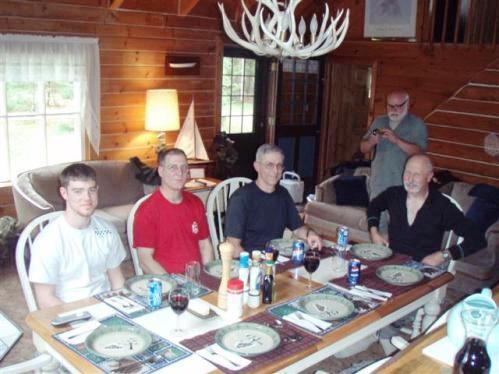
Plan D
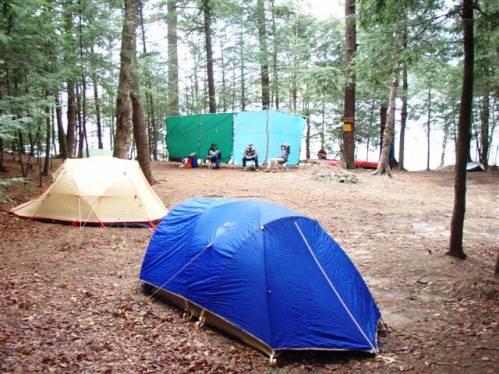
Pollywog Pond Camp
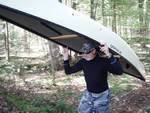
One Trip
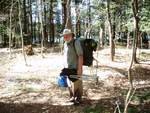
Two Trips
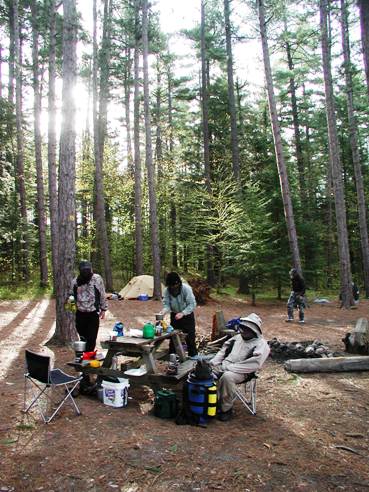
Late Breakfast Blackfly

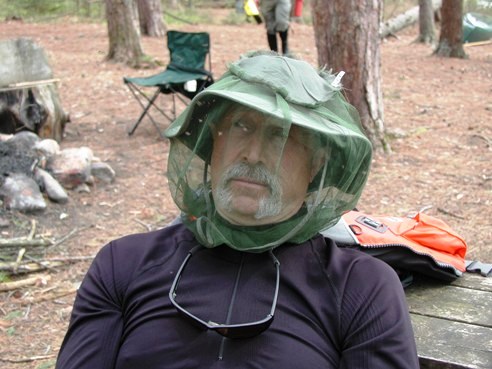
Ralph eyes bugs
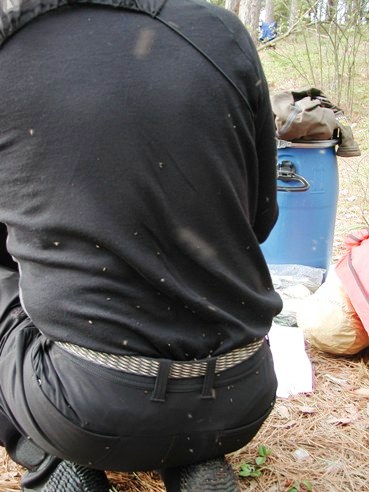
Scott back bugs
